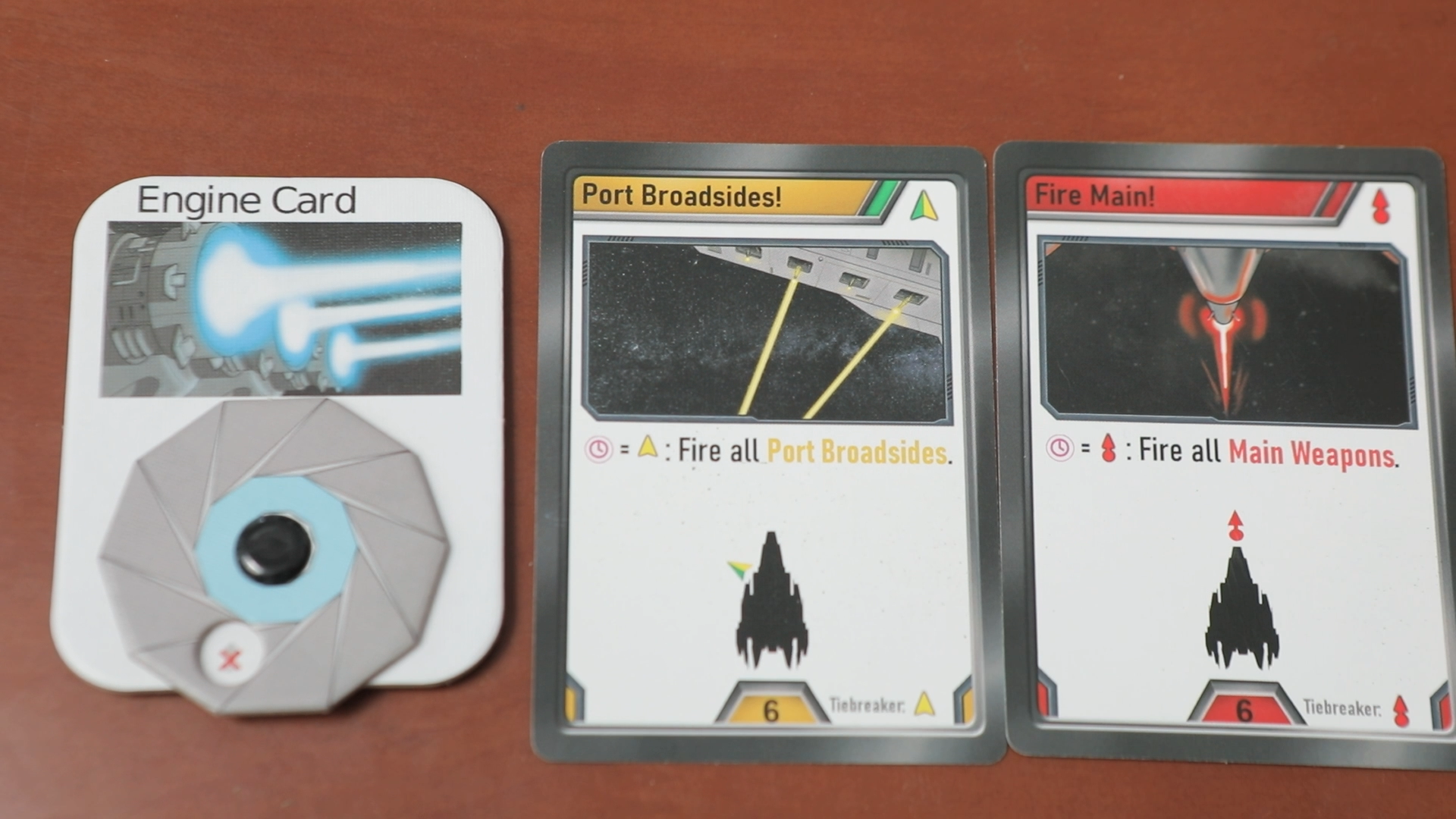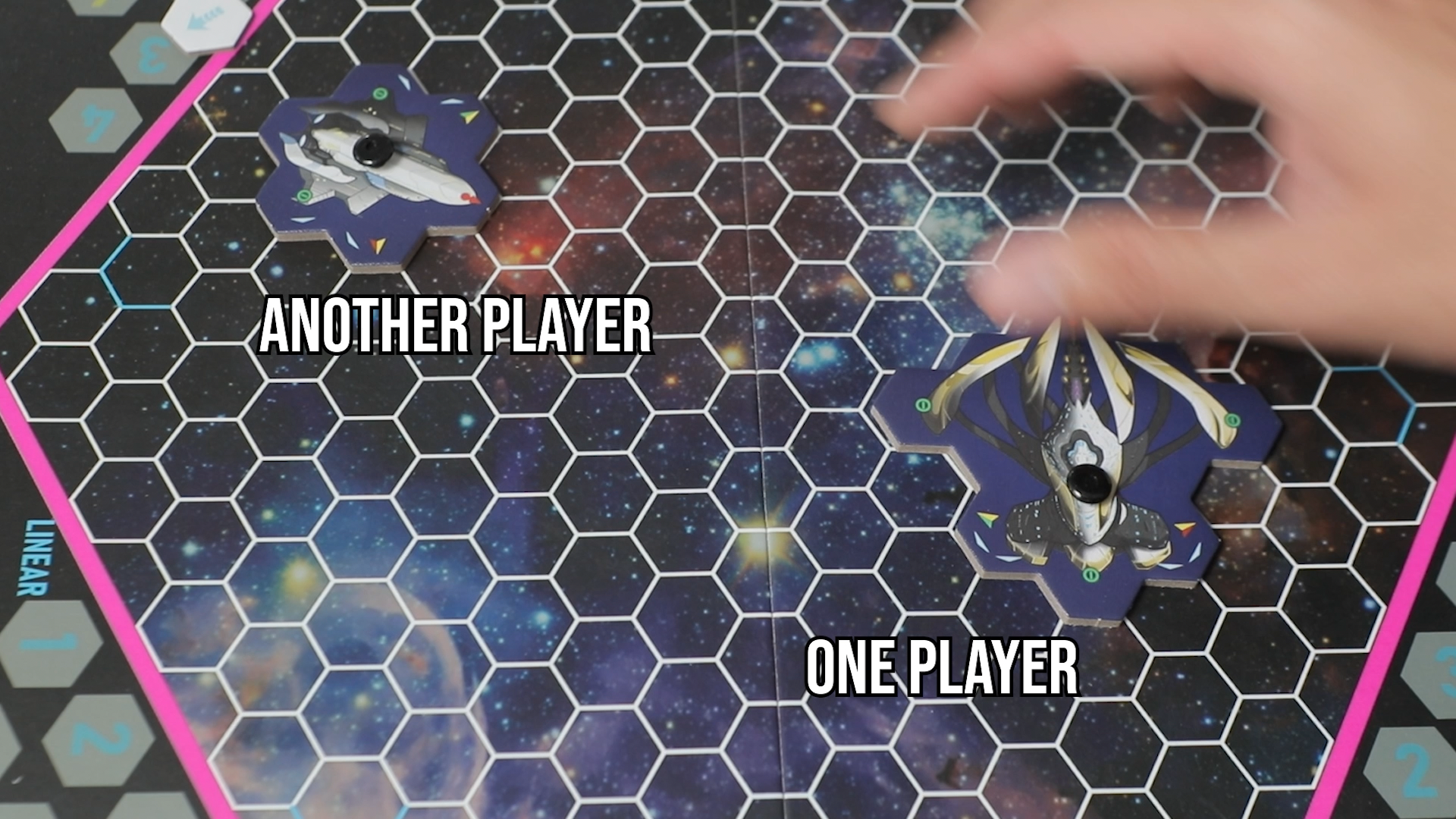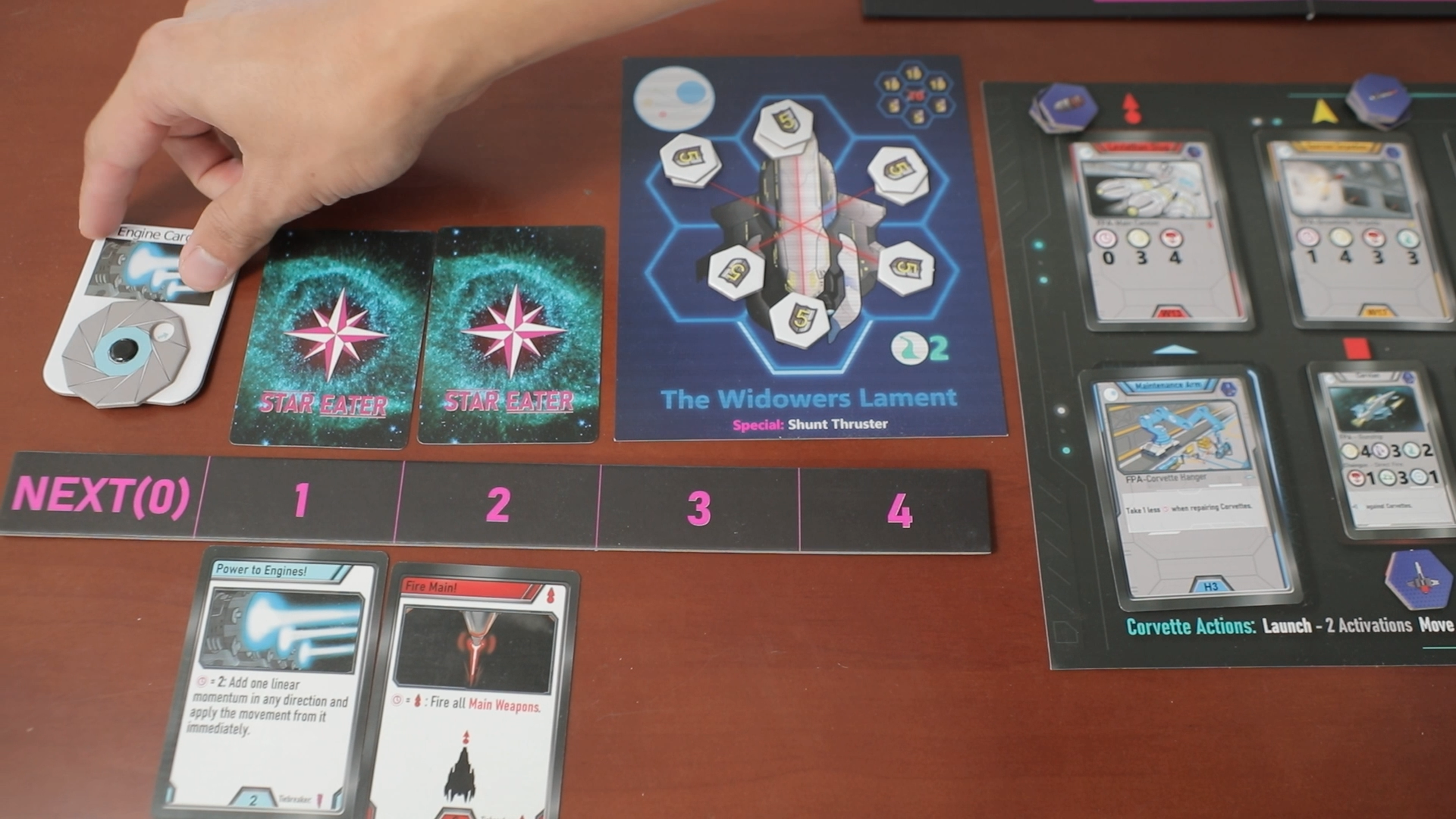Star Eater Review
Outmaneuver and outgun your opponent’s capital ship, using inertia!
An indie space game, where you pick a ship, customize your load outs, then carefully maneuver your ship to launch brutal broadsides into your opponent. Also launch and activate fighter ships! This mostly 1v1 game runs about 1.5 hours.
Video published October 6th, 2022

Pick a unique Capital Ship, and fire your engines, considering Momentum.

Customize your ship's defenses, weapons, and more!

Program cards, and manipulate their cooldowns!
This is a sponsored post.
Overview & How to Play
Have you heard of Star Wars? You know, that universe where there’s massive ships, like Star Destroyers, launching Tie-Fighters into space to destroy other ships? That’s kind of like Star Eater!
Star Eater has players selecting a unique capital ship, customizing its interior, then sailing out to battle to kill an opponent’s capital ship, to reduce their health to 0. To do that, you’ll want to attack your opponent enough to destroy their armor in certain sections, then attack through those weakened section to damage their interior hull and drop that to 0.
In practice, every turn, players first play 3 things face down: an Engine card, then 2 cards from their hand of 8. The Engine Wheel will give your ship additional movement in that direction, and the cards can fire weapons, activate smaller ships called Corvettes, or move your engines again.
These are all set or programmed at the same time, then you activate the engines first: both players add their selected token to their current movement, because momentum is a thing in this game! See, every time you program movement, that STAYS with the ship, so every time you play more movement, you’re adding onto previously programmed movement, meaning you’ll be moving in those direction(s) for the rest of the game until something else happens, like you deciding to move the other way to cancel previous movement. You can also choose to rotate off of your engine command.
After the movement stuff, you activate your first programmed card, which will typically activate a part of your ship that you’ve customized: like saying you’ll fire your main weapon, which fires your corresponding weapon in that weapon slot. Just try to aim it from your ship’s weapon directions towards your opponents’, making sure you’re within range!
Once players both use their 1st programmed cards, they use their second, and then the turn ends! Put cards on cooldown when they say so, grab previously used cards, and start a new turn.
One last thing: remember how we mentioned Tie-Fighters in Star Wars up above? Well that’s in this game, through something called ‘Corvettes’. These are fighter ships that you can launch from your ship’s hangers, which can be directed to move and fire their weapons upon you programming a card called ‘Corvettes!’. Lotta options you can choose to program with, but hey, for that, let’s get into the pros!
Pros
For a game all about the ships, does Star Eater really get you into it with the unique ships, with different shapes, center of mass, weapon bank locations, and even hanger locations! But more on ships after we talk about the interesting ship movement!
Star Eater is calling itself “Inertial Space Combat”, and that definitely comes through with the momentum, where because your engine movement compounds with previous turns, your movement could become really fast if you want it to be, filled with rotations and different directions for clever positioning to outflank your opponent. It’s immediate where the mind games go, as both admirals are programming their ship to thrust their engines in a secret direction every turn, even choose to negate their current trajectory if they want. Or maybe don’t negate your trajectory because you can ram your ship into your opponent to do damage to both of you based off of your current movement speed! There’s a lot of flexibility as we get into the card programming, with a card called “Power to Engines”, that lets you move your engines again in one turn if you want!
Speaking of card programming, this game has standard fare for military ships: firing Starboard Broadsides, Port Broadsides, or Frontal batteries. But the holy grail card that jumped out to use was “Vent Coolant”, an card that unlocks so much flexibility by allowing you to use previously programmed cards that are ‘cooling’ down, at the cost of pushing back their cooldown back by a bit. Like, thank goodness this card exists, because it prevents game states where players have already programmed their strong cards and are outta cool options (Only 8 cards you are programming). With “Vent Coolant”, you have to watch for your opponent’s capacity to Vent Coolant to do back-to-back attacks on you.
We might as well shoutout the Corvettes too, which are the smaller ships on the board that are the ‘Yin’ to the big capital ships’ ‘Yang”. Corvettes rotate on a dime, move fast, and can weave in and out of tight spots. But they have no armor like the capital ships, and will immediately blow up if they touch anything. So this makes Corvette positioning really nuanced every turn, being a layer on top of your capital ship that you have to worry about. There’s essentially a lot of options you get by launching Corvettes through your hanger bay, as Corvettes are in a different location of the board, but they require some management, as you have to use the “Corvettes” card to use them.
And the Corvettes also feel like real fighter ships! You can use them to flank your enemy with Torpedo Bombers, or set up defenses with barricades!
The game rounds out the smaller tokens with Cannons and Torpedos, both things that are also flying forward with their own movement around the space board! These are also cool to plan around (and choose to fire from your ship’s batteries), since Cannons do the most damage and fly the fastest, but Torpedos have built in ‘homing’ technology to rotate towards enemy Capital ships. Essentially, you gotta pick the right tool for the job with these, which is a fun choice. Or you can say, screw it, I don’t want to have launch these smaller projectiles, and the game lets you deck out your ship with beams, which are like railguns!
We can’t go and mention every single weapon ability, but know that there are a LOT of different weapons to choose from… just like there are a bunch of ships to choose from! In fact, there are 9 different Capital Ships, with not only different centers of mass that matter for turning, but special abilities!
You can launch EMPs to destroy every single Corvette or Torpedo in front of you. Or launch an “Onslaught” by firing every single weapon at once! Or some ships can even let you teleport!
Like no kidding, when you factor in each ship’s special ability with their different hull strengths, like some ships have 0 armor in their back, it makes you really question each game’s strategy as you fly around. And you can customize each ship!
Star Eater has exceptional replay value, as you can customize what cards you want to put in certain sections of your ship, like Frontal Weapons, Port/Starboard Weapons, Hanger Bays, Point Defense Systems, and even Corvette abilities! There’s 3 different factions, that each have 3 cards to choose from for each weapon, with 3 different Corvettes for each faction. Mix and match Cannons, Beams, Torpedo Bombers, Capital Ship abilities, etc. etc. to your heart’s content!
Oh, and the game runs generally true to time at 45 minutes a player… but don’t get up your hopes for multiplayer!
Cons & Nitpicks
The multiplayer does feel a little out of place, and not something we would recommend, mostly because the board does not scale. See, with ships constantly moving and firing stuff, it feels tight for 2 players, and totally makes sense to prevent the game from running too long. Once you add in another Capital Ship, each with their own projectiles and Corvettes taking up space, you lose a LOT of space on the board.
This isn’t even to mention how ramming becomes really wonky in 3 player, which is a free for all, since ramming someone is just strictly bad, as whoever isn’t getting rammed will not take any damage and be hilariously chill firing their weapons from afar, as the other 2 players entangle themselves.
Sure, the 2v2 is probably slightly better, and neither of these modes seem to be broken in terms of mechanics, but the focus of Star Eater is really the 1v1, at least with this board so make sure that’s what you’re primarily getting this for.
The rest of the cons could actually all be grouped as under: Indie game issues, where there isn’t always the same polish as bigger publishers have. Like, the rulebook had some hard to read font on the examples, and a lack of examples for certain cards. Or how it doesn’t specifically tell you what 8 command cards each players should grab, which are is a CORE aspect of the game that players use every turn to program. Or how the player aids have the right information, but are annoyingly double sided. The biggest annoyance was how it doesn’t explain ship abilities much, whether it be for the Capital Ships, or the Corvettes.
During gameplay, the Corvettes are also extremely hard to distinguish, because their color indicator is a little tiny bubble on each Corvette, leading to all sorts of confusion of which Corvette corresponds to what card during gameplay. Plus, their card that has their stats and ability, is very small and cramped. Both the token and card for Corvettes should have been bigger, since they end up being a key aspect of the game.
There’s a couple of nitpicks that didn’t affect scoring, like the game’s insert not fitting the tokens at all, forcing you to get multiple plastic bags, or how there’s some typos. The biggest missed opportunity here was the chance to flesh out the lore of each of the 3 factions more, where factions have certain ships and weapons, but no explanation for each faction. Like, some ships, or some weapons get blurbs of text, but not the 3 factions, which gives players a REASON for fighting each other, and to help understand ship customization more.
Final Thoughts
We go back to the “inertial space combat” printed on the box, and Star Eater definitely feels that way as you worry about moving your ship’s thrusters in different ways, playing off of both players previous movements. And this momentum system has tons of bells and whistles with ways to deck out your ship, or swap out supplementary corvettes, all while having gameplay still be centered around 3 things: 1 engine program, and 2 action cards.
Admittedly, the visual design is kinda janky, but that only area that really hurts gameplay is the Corvettes, the rest of aesthetic is subjective. The game would likely look better if made by a bigger studio, but would also probably not have the ridiculous quantity of ships in a single base box. Like, if this was packaged differently, it could have been $40, only come with 3 ships, a handful of customizable cards, then a TON of add-on expansions. But that’s not the indie heart of this!
Star Eater gameplay is an awesome premise for most sci-fi fans, with gameplay that is not only tense and promotes creativity, but will have lots of longevity with ways to deck out your ship. If the movement and programming system is something up your alley, and you’re ok with the jank, then you have a customizable dueler you can play a LOT.






















